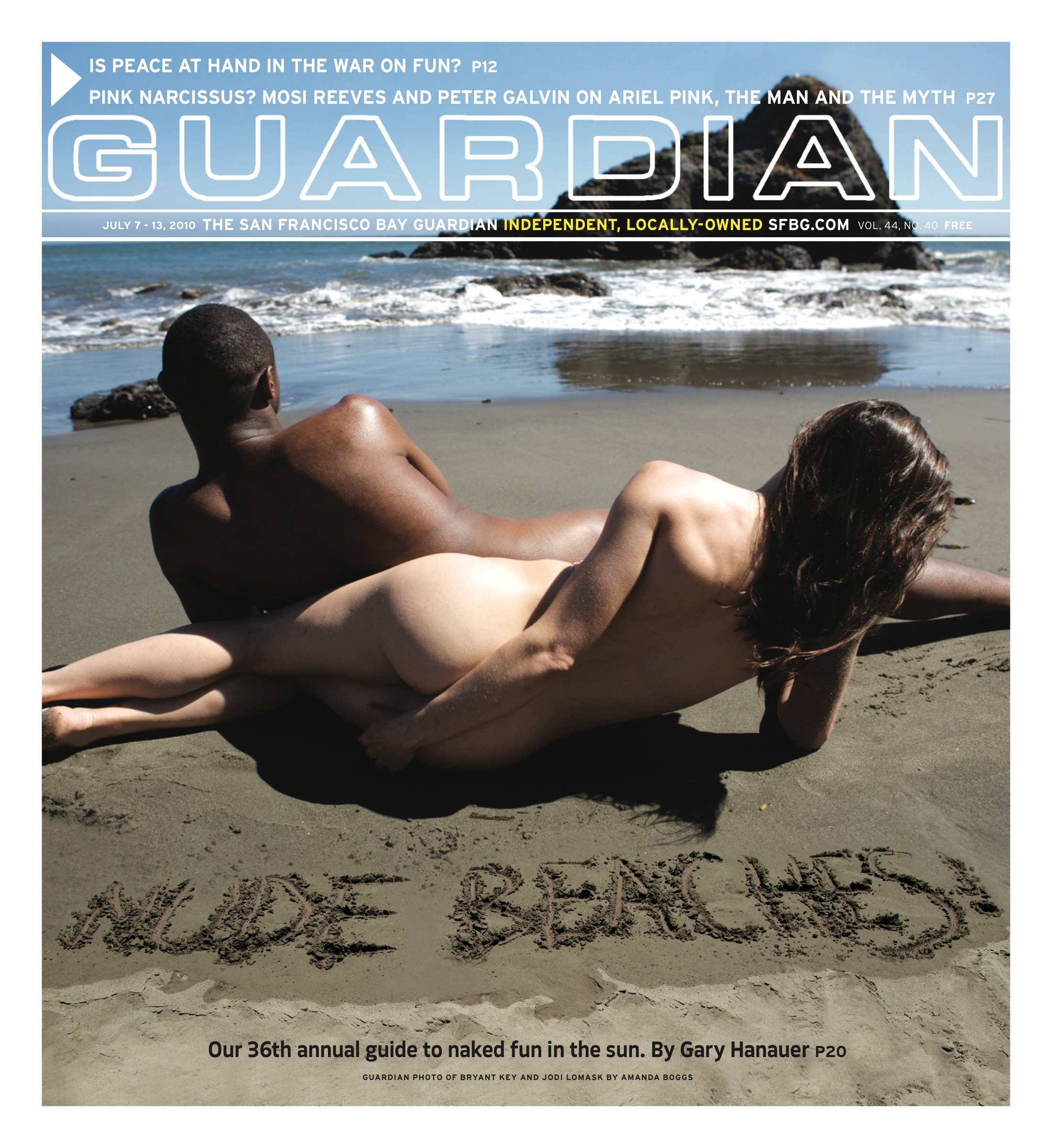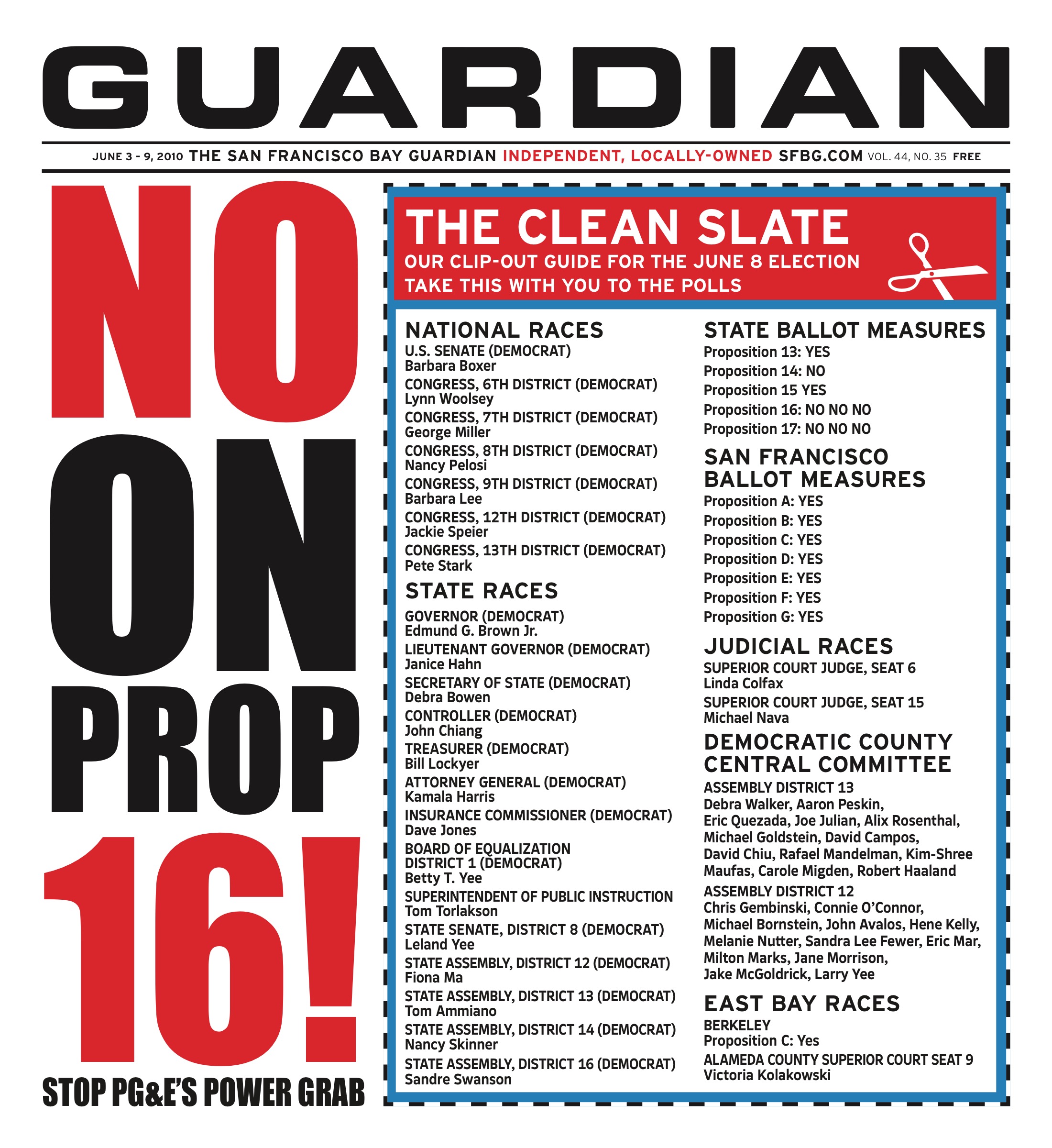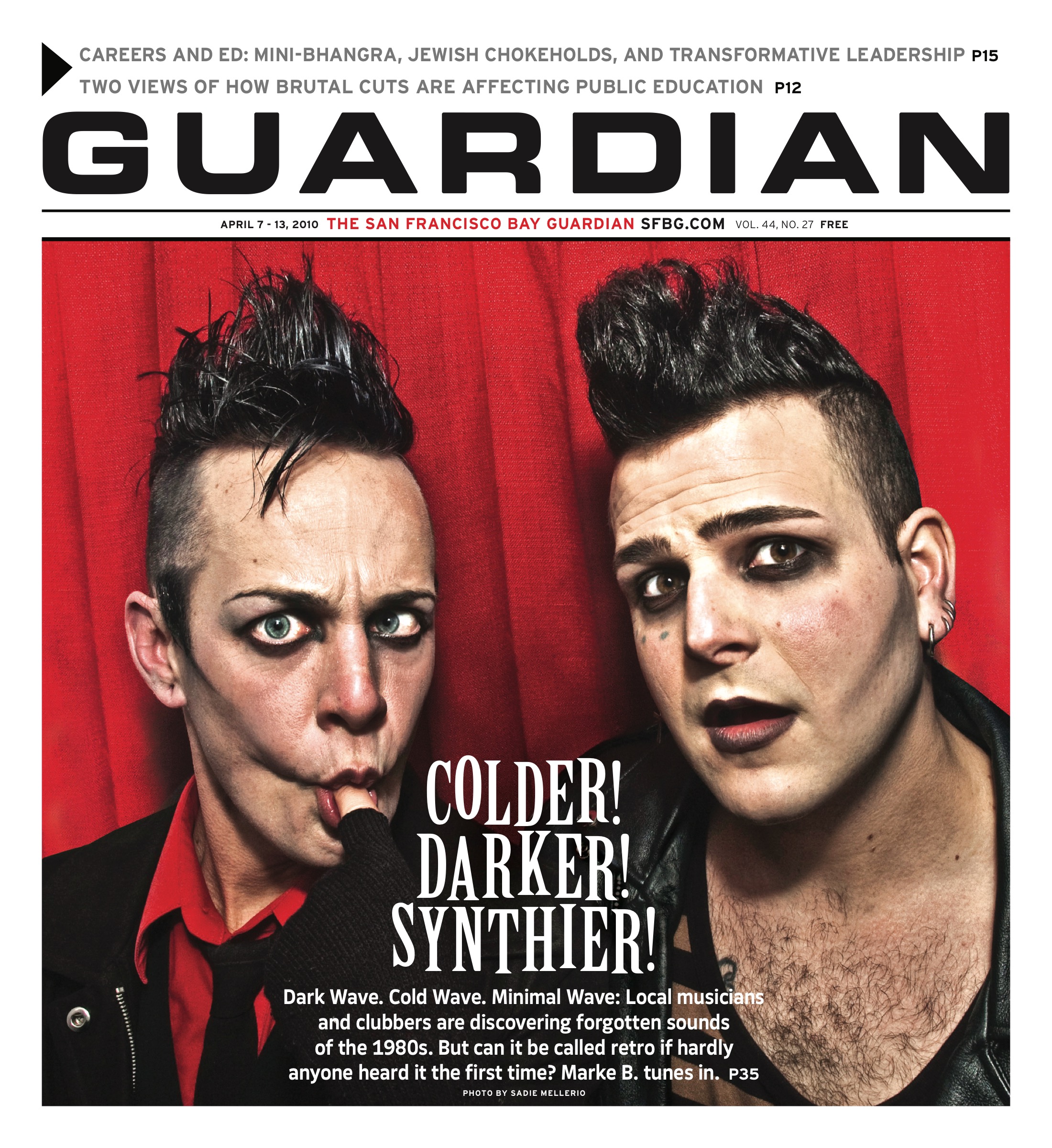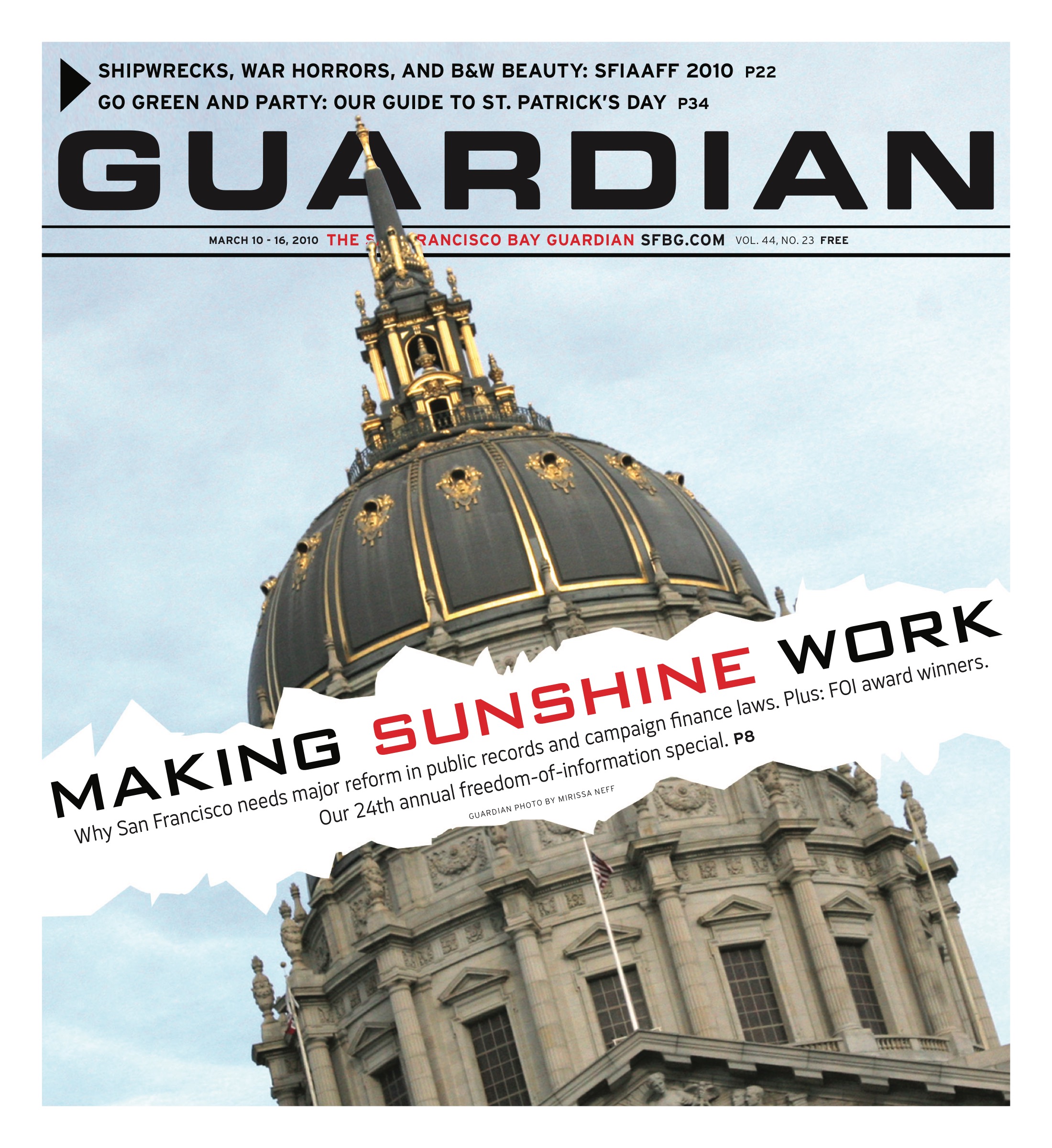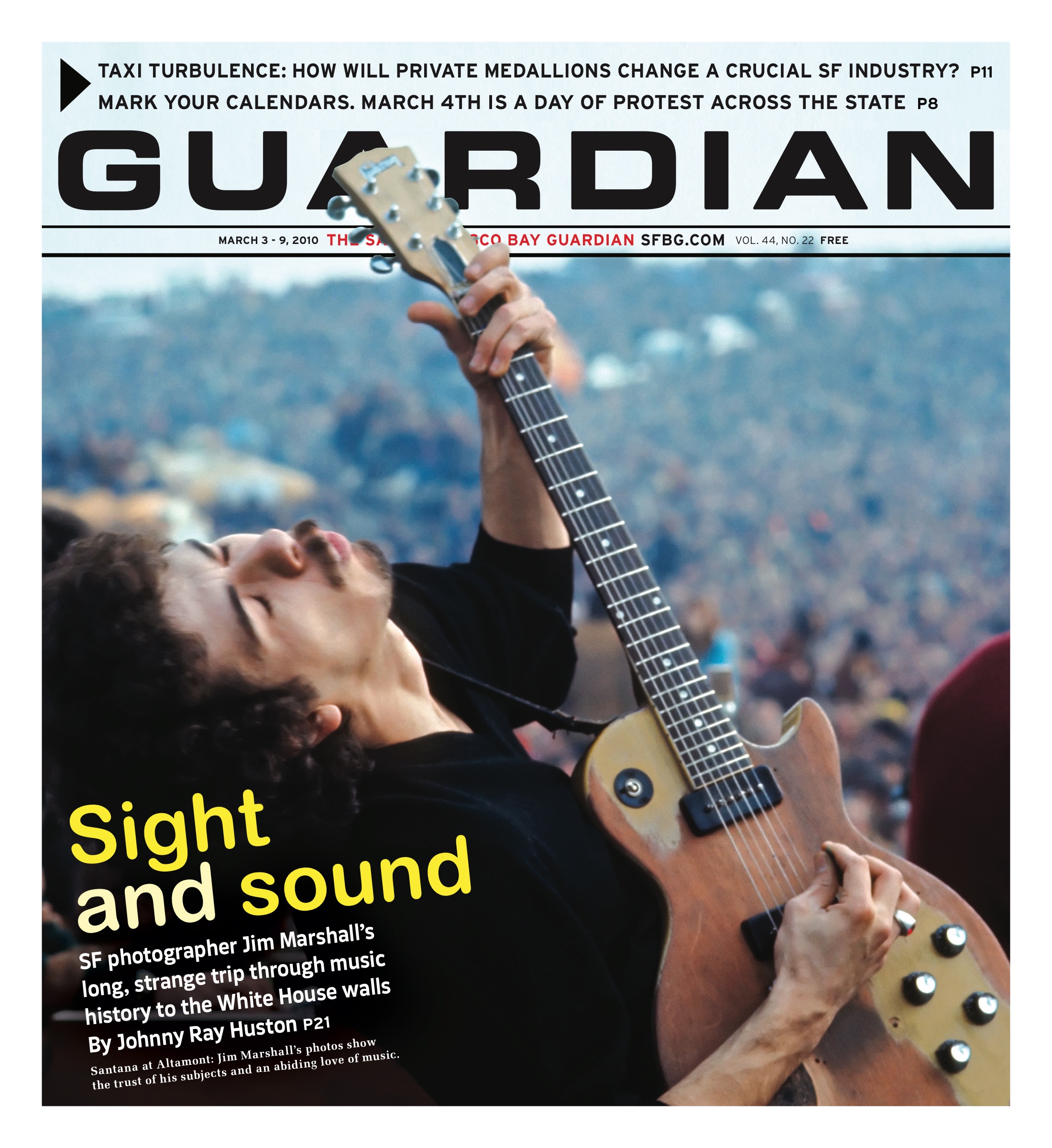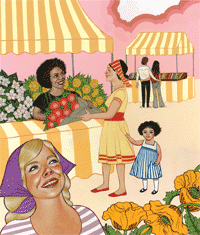BEST INDEPENDENT BOOKSTORE; BEST USED BOOKSTORE
Green Apple
With thousands of dirt-cheap books, CDs, and DVDs, Green Apple is worth visiting for the witty staff picks alone.
506 Clement, SF. (415) 387-2272, www.greenapplebooks.com
Best Independent Bookstore runners up: Books, Inc., City Lights
Best Used Bookstore runners up: Dog-Eared Books, Aardvark
BEST COMIC BOOK STORE
Isotope
Mainstream comics are represented at Isotope, but its raison d’être is small-press, independent, and self-published varieties.
326 Fell, SF. (415) 621-6543, www.isotopecomics.com
Runners up: Whatever, Al’s Comics
BEST MAGAZINE SELECTION
Fog City News
Nibble designer chocolates while you sift through a staggering selection of magazines, including more than 700 foreign titles.
455 Market, SF. (415) 543-7400, www.fogcitynews.com
Runners up: Issues, Farley’s
BEST SPECIALTY BOOKSELLER
Borderlands
This Mission District shop, specializing in fantasy, horror, and science fiction, hosts an author nearly every week.
866 Valencia, SF. (415) 824-8203, www.borderlands-books.com
Runners up: Babylon Falling, Get Lost
BEST PLACE TO BUY VINYL; BEST PLACE TO BUY CDS
Amoeba Music
A Bay Area institution, Amoeba features a formidable vinyl collection and bargain bins overflowing with cheap used CDs.
1855 Haight, SF. (415) 831-1200; 2455 Telegraph, Berk. (510) 549-1125; www.amoeba.com
Best Place to Buy Vinyl runners up: Grooves, Open Mind
Best Place to Buy CDs runners up: Rasputin, Streetlight Records
BEST PLACE TO RENT MOVIES
Le Video
Conceived when the Parisian owner couldn’t find the cult and foreign films she craved, Le Video is known for its large, eclectic inventory.
1231 Ninth Ave., SF. (415) 566-3606, www.levideo.com
Runners up: Lost Weekend, Faye’s
BEST CLOTHING STORE (WOMEN)
Ambiance
Ambiance junkies love the store’s dedicated staff and massive selection, stretching across several budget octaves and featuring brands like Free People, BCBG, and Betsey Johnson.
1458 Haight, SF. (415) 552-5095; 3985 24th St., SF. (415) 647-7144; 1864 Union, SF. (415) 923-9797;
Runners up: Crossroads Trading Co., Brownies Vintage
www.ambiancesf.com
BEST CLOTHING STORE (MEN)
Indie Industries
The pared-down Berkeley storefront features prints, graphic tees, hoodies, and dresses by in-house artisans, plus anime-inspired kitsch.
2003 Milvia, Berk. (510) 549-3285, www.indieindustries.com
Runners up: Cable Car Clothiers, Five and Diamond
BEST CLOTHING STORE (KIDS)
Chloe’s Closet
Visit Chloe’s for the big selection, sweet Bernal Heights location, and homey atmosphere that’s earned it accolades four years running.
451 Cortland, SF. (415) 642-3300, www.chloescloset.com
Runners up: Little Fish, Pumpkin
BEST LOCAL DESIGNER
 Nicacelly: Best Local Designer
Nicacelly: Best Local Designer
GUARDIAN PHOTO BY MATTHEW REAMERNicacelly
Nicacelly’s designs are as colorful and eclectic as San Francisco itself — imagine a schizophrenic geisha sightseeing in Thailand while moonlighting as a hip-hop DJ. You can find her styles at True, Upper Playground, and Density, among other locations.
www.nicacelly.com
Runners up: Linda Pham, Sunhee Moon
BEST VINTAGE CLOTHING STORE
Brownies Vintage
Brownies has an unusual specialty: deadstock vintage that’s never been washed or worn. The unassuming shop also carries new styles by local and independent designers.
2001 Milvia, Berk. (510) 548-5955, www.brownies-vintage.com
Runners up: La Rosa, Painted Bird
BEST THRIFT STORE
Thrift Town
Thrift Town’s not your tame little vintage boutique — it’s a massive beast of a thrift store, with a huge selection and dizzyingly low prices.
2101 Mission, SF. (415) 861-1132, www.thrifttown.com
Runners up: Community Thrift, Out of the Closet
BEST SHOE STORE
Shoe Biz
If Kelly of YouTube fame were to shop at any of these footwear outlets, he/she could have only one response: these shoes rule.
1446 Haight, SF. (415) 864-0990; 877 Valencia, SF. (415) 550-8655; 3810 24th St., SF. (415) 821-2528,
www.shoebizsf.com
Runners up: Gimme Shoes, Rabat
BEST FURNITURE STORE
Propeller
Propeller mixes whimsy, beauty, and function in its showroom, featuring items like ceramic deer-head wall hangings, a chair made to look duct-taped, and dishes that look like they’re in motion.
555 Hayes, SF. (415) 701-7767, www.propellermodern.com
Runners up: Zonal, Monument
BEST VINTAGE FURNITURE STORE
Monument
Perfect for buying your home’s centerpiece item or simply getting inspiration, Monument has an impressive selection of modern and deco furniture.
572 Valencia, SF. (415) 861-9800, www.monument.1stdibs.com
Runners up: The Apartment, X-21
BEST FLEA MARKET
Alemany Flea Market
Smaller than Alameda’s but more charming, the Sunday Alemany market is a haven for hipsters seeking ironic art, vintage housewares, old tools, and antique art-projects-to-be.
100 Alemany, SF. (415) 647-2043
Runners up: Alameda, Ashby
BEST HARDWARE STORE
Cole Hardware
Friendly staff, an impressive selection, and convenient locations have made this independently owned shop a Bay Area favorite since 1920.
956 Cole, SF. (415) 753-2653; 3312 Mission, SF. (415) 647-8700; 70 Fourth St., SF. (415) 777-4400
2254 Polk, SF. (415) 674-8913; www.colehardware.com
Runners up: Brownie’s, Cliff’s
BEST INDEPENDENT TOY STORE
Ambassador Toys
A wonderland of toys, puzzles, coloring books, vintage race cars, collectible dolls, and other unique gifts for kids, Ambassador further charms shoppers with free gift wrapping.
186 West Portal, SF. (415) 759-8697; 2 Embarcadero Center, lobby level, SF.
(415) 345-8697, www.ambassadortoys.com
Runners up: The Ark, Mr. Mopps
BEST SHOP FOR PARENTS-TO-BE
Natural Resources
Encouraging mindfulness in pregnancy and child rearing, Natural Resources is an eco-boutique as well as an educational resource.
1367 Valencia, SF. (415) 550-2611, www.naturalresourcesonline.com
Runners up: Day One, Chloe’s Closet
BEST PET SHOP
Bernal Beast
Locals love Bernal Beast’s courteous staff, merchandise selection, unique treats (antlers as a chew toy!), and fantastic raw food section.
509 Cortland, SF. (415) 643-7800, www.bernalbeast.com
Runners up: Best in Show, Noe Valley Pet Co.
BEST QUIRKY SPECIALTY STORE
Paxton Gate
A more eclectic selection of bones, stones, taxidermy, rare plants, and oddball collectibles than Paxton’s could only exist in a gothic novel.
824 Valencia, SF. (415) 824-1872, www.paxtongate.com
Runners up: Heartfelt, Wishbone
BEST SPORTING GOODS STORE
Sports Basement
Whether it’s yoga mats, running shorts, tennis rackets, or basketballs you need, this is the place to get them — and often at warehouse prices.
1590 Bryant, SF. (415) 575-3000; 610 Mason, SF. (415) 437-0100; www.sportsbasement.com
Runners up: See Jane Run, Lombardi’s
BEST PLACE TO BUY CAMPING GEAR
REI
It’s difficult to find a retailer with a better selection of outdoor gear, from trek shoes to white-water rafting oars — and the return policy for members is unmatched.
840 Brannan, SF. (415) 934-1938, www.rei.com
Runners up: Sports Basement, Wilderness Exchange
BEST PLACE TO BUY BIKES AND GEAR
Mike’s Bikes
Mike’s does sell bikes and gear, but it’s best known and loved for its knowledgeable, reliable, and friendly service staff.
1233 Howard, SF. (415) 241-2453, www.mikesbikes.com Valencia Cyclery, American Cyclery
BEST ECO-FRIENDLY RETAILER
Rainbow Grocery
Featuring organic produce at good prices, natural bath and body products, and a selection of vegan, vegetarian, gluten-free, and other specialty items, Rainbow pleases a full spectrum of shoppers.
1745 Folsom, SF. (415) 863-0620, www.rainbowgrocery.org
Runners up: Elephant Pharmacy, Spring
Shopping — Editors Picks
BEST SUI, SHARP AND SWEET
 Sui Generis: Best Sui, Sharp and Sweet
Sui Generis: Best Sui, Sharp and Sweet
GUARDIAN PHOTO BY SAMANTHA BERGDespite the vast numbers of stylish males who haunt our fair burg, shopping for menswear in San Francisco can be a real downer. You’re either pummeled with dopey high-end “designer” street labels à la G-Star or forced to piece together a credible look from scattershot resale sources — not a bad option in itself, except that every other subculturally fashion-conscious Y-chromosomer is usually elbowing you out of the way to get to the good stuff. Enter Sui Generis, a boutique of impeccably vetted men’s vintage wear on Church Street (another location, featuring dressier consignment duds, recently opened on Market Street). The Generis gentlemen hand-select a dossier of ultrasharp hand-me-down duds that poke the up-on-it eye with longing — rare and perfect tees, plaids of fondest dreams, jeans that scream “do me,” fedoras, scarves, footwear, more — and force us to re-evaluate our look every time we glance up at its display windows. A good thing, then, that Sui’s also manageably affordable. And one-of-a-kind cache is part of the value: no chance of running into your twin from Rolo or Nomads, here.
218 Church, SF. (415) 436-9661; 2265 Market, SF. (415) 437-2265, www.myspace.com/suigeneris_sfo
BEST PLACE TO FIND RARE NUTS
Sure, Valencia Cyclery has a whole store full of bikes, locks, tools, lubricants, and clothes at their 1077 Valencia showroom, but what makes them so magical is the 1065 Valencia repair shop. They opened in 1985, which means if you need a roller cam on an early Suntour mountain bike brake, a rebuild kit for a Sturmey Archer 3 speed hub, or just a hard-to-find nut with an odd thread pitch, you’re stoked. The back rooms have shelves and drawers full of every imaginable wingding and doohickey for your two-wheeled best friend — and if what you need isn’t there, the manager will order it. The mechanics are actually people you’d trust to work on your bike, not ham-handed hacks with their thumbs on backwards. And best of all, they explain things in plain English, not cooler-than-thou biker-ese.
1065 and 1077 Valencia, SF. (415) 550-6600, www.valenciacyclery.com
 Sara Brownell and Nici Williams of
Sara Brownell and Nici Williams of
Brew Holster Cult: Best Beer Helmet
GUARDIAN PHOTO BY SAMANTHA BERGBEST BEER HELMET UPGRADE
You’d think hipsters would’ve come up with an answer to beer helmets ages ago. But it wasn’t until saucy AC/DShe rock ‘n’ roll vixens Nici and Sarah began to face technical tippling difficulties at their shows — including drenched T-shirts and wet amps — that the Brew Holster was born. The studded leather gun sling, created by the girls in their backyard chop shop, kept the rockers’ drinks close and off their clothes while still looking badass. So how to join the Brew Holster Cult? Simply buy one off the Web site and wear it to backyard BBQs, outdoor concerts, all-night barhops, or wherever you need to rock out with your cock out or jam out with your clam out — without losing your booze. Brew it to it!
www.brewholstercult.com
BEST FARM-FRESH FASHION
Quaint, antique- and decor-store-lined Jackson Square got a little chicer — and a little more fashionista-friendly — when Carrots moved into the gracious hood. Sisters Melissa and Catie Grimm named their sublime boutique, tongue firmly placed in cheek, after the petite veggies that built their family’s business, Grimmway. Yet we couldn’t be further from the farm amid Carrots’ lofty yet elegant, European-inspired mix of antiques and industrial decor touches. Visitors are welcome to sip an espresso beneath the zinc 19th-century chandelier while browsing the wares of such covetable young designers as Thakoon, Stella McCartney, Narcisco Rodriguez, Vanessa Bruno, and Peter Som. Men can also find fashion respite courtesy of such desirables as Band of Outsiders, Obedient Sons, and Rag & Bone. The free mini carrot-cake cupcake isn’t your only reward for stopping by and discovering the ideal piece.
843 Montgomery, SF. (415) 834-9040, www.sfcarrots.com
BEST ONE-STOP MAELSTROM OF METAL
Chances are, if you’re at all familiar with the Bay Area metal scene, you’ve crossed paths with Shaxul, proprietor of Shaxul Records. In addition to distributing and releasing local and rare metal albums, Shaxul hosts a monthly radio show on KUSF (all-metal, natch) and runs a snug storefront on Haight Street, boldly perched opposite the megasize Amoeba Records. The walls are black and decorated with all manner of posters and T-shirts (including a particularly rad High on Fire tee that is sold out on every Internet vendor you might think of). The shelves are packed with vinyl (them things you put on a record player, kids!), CDs, DVDs, and more. And you ain’t gonna find no wimpy selections here: Shaxul almost exclusively stocks bands with names that’d scare your grandma, with brutal sounds to match. Both current (Saros, Hammers of Misfortune, Asunder) and classic (Death, Exodus, Testament) acts are well represented. Emo kids stay home! Everyone else, horns up.
1816 Haight, SF. (415) 831-5334, www.shaxulrecords.com
BEST VOODOO NOSE CANDY
Helen Keller once said, “Smell is a potent wizard that transports you across thousands of miles and all the years you have lived.” Which may be true, but she forgot to add that it can also be used to accumulate money, secure a long life, and get back at your ex for blowing your housemate. The aromatic candles, incense, and powders at Yoruba Botanica, a Santeria store in the Mission District, have been imbued with a potent form of South American sorcery, so choose your scents wisely. You don’t want to mistakenly buy a death candle for your arthritic grandmother, or some romance dust for your creepy bi-curious roommate. A consultation with one of the women who run Yoruba Botanica will ensure you get the correct smell for your purposes. And for a small fee, they’ll take you in back, read your fortune, and maybe even tell you how to score more ass.
998 Valencia, SF. (415) 826-4967
BEST NOMADIC HIPSTER BOUTIQUE
The Mission Indie Mart, a roaming thrift store, local design showcase, and barbecue that takes place monthly in backyards and at dive bars throughout the Mission District was dreamt up by Kelly Malone, a tattooed hipster chick with three lifelong obsessions: DIY fashion, hard drinking, and good times. Sadly, while her hobbies did wonders for her social life, they caused quite a stir at the Gap, where Malone had been working for more than 10 years. So she set up her own business. Her brainchild has become a staple of Mission dwelling: a monthly opportunity to mingle with artists, musicians, fashion designers, misfits, and fall-down drunks like the founder herself, whose hourly announcements at MIM evolve throughout the day from straightforward information to inebriated performance art. Her best line to date: “The bathrooms are in the back, the T-shirts are in the corner, and the vodka is in my belly. Now come on stage and let’s get naked, bitches. Wooo!”
www.indie-mart.com
BEST BONBON BAR
Charlie’s chocolate factory may be pure fiction, but Miette Confisserie is pure magic. This Hayes Valley confectioner, sister to the Ferry Building’s Miette Patisserie, brings European decadence and childlike devotion to the candy-shop concept. Walls are lined floor-to-ceiling with apothecary jars filled with imported boiled sweets, Dutch licorice, saltwater taffy, fine chocolates, and buttery caramels — all of which can be packaged in custom boxes tied with satin ribbons. But you don’t have to take your treats home. Miette hosts children’s birthday parties, complete with ballerinas, storytelling, and pony rides. Not a breeder? Adults can play too, with private evening fetes featuring champagne and cotton candy. Either option is ideal, considering Miette’s decor is as winsome as its sweets: if the perfectly salted walnut shortbread doesn’t charm you, the black-and-white checkerboard floor surely will.
449 Octavia, SF. (415) 626-6221
BEST WAY TO LEAVE A PARTY WITHOUT YOUR CLOTHES
Alternative economies sound nice in political lectures at the University of California, Santa Cruz, but they rarely thrive in real life. Sure, there are little free markets that crop up in cities across the world, but they’re usually full of questionable scavengers, dirty hippies, and slumming rich kids temporarily rebelling against “the Man.” And then there’s the stuff they trade — the idea that one man’s trash is another man’s treasure just doesn’t hold water when you see the usual pile of broken plates, outdated VCRs, and defunct Web site promo T-shirts. But thanks to the hipsters behind SwapSF, one experimental trade economy seems to be working. Their secret? Alcohol and music, of course. SwapSF is a seasonal warehouse party that charges $5 and a bag of clothes for entry. It’s a small price to pay for access to dope beats, an open bar, and all the cool togs your friends bought and never wore.
www.swapsf.com.
BEST FRENCH WINE WAREHOUSE
Many people are frightened of French wine, particularly the indecipherable and austere-looking labels — but not you. When your friend goes to a Halloween costume party as an uncorked bottle of Château d’Yqem, you are savvy enough to be amused. You are also savvy enough to know where to find deals on French (and other European) wines — which can still be found despite the dollar’s collapse against the euro: The Wine House. The warehousey setting on the northern foot of Potrero Hill assures you that it’s not ambience or fancy shelving you’re paying for. The staff is knowledgeable, helpful, and friendly. And there are plenty of offerings from Burgundy, Bordeaux, and lesser-known winegrowing regions, especially those in the south of France. Many wines are priced near $5 a bottle, making them competitive with Trader Joe’s plonk. Best of all are regular case discounts, from 10 percent on up, along with occasional case specials (often on fine Côtes du Rhône) even more drastically discounted.
129 Carolina, SF. (415) 355-9463, www.winesf.com
BEST ECO-SPOT FOR NOE TOTS
Ensure the longevity of both your children and the world they’ll grow up in at Mabuhay Kids, an eco-friendly baby boutique in Noe Valley named for the Filipino phrase for “long life.” Sporting eco-friendly, safe, and stylish attire from global and local designers, Mabuhay (pronounced “ma-boo-hi”) is a must for JAKC’s organic baby blankets, Stubby Pencil Studio’s soy crayons, and much more. Why trick out your toddlers with gun-toting G.I. Joes or sweatshop OshKosh B’Gosh overalls when you can provide them with sustainably harvested rubber tree tricycles or duds from Ses Petites Mains, who make organic French fashions for little ladies? In light of massive baby product recalls, this is a shop whose wares you can trust — whether your moppet’s got ’em on her bod or in his mouth. Plus, for Noe dwellers, it’s just one biodiesel stroller ride away.
195 Church, SF. (415) 970-0369, www.mabuhaykids.com
BEST MASTERS OF MYSTERY
A bookstore that sells mysteries shouldn’t be clean and well-lighted. It should look and smell and feel like it came out of the dark streets of Victorian London. And although the San Francisco Mystery Bookstore isn’t by any means dingy or dank, it’s got that wonderful cluttered feel of a place owned by someone who loves books and tolerates a bit of chaos. There are paperback mysteries everywhere — in the shelves, on the windowsill, stacked up by the cash register, tucked away in the back. They’re brand-new, used, or very old and valuable. There are selections by famous authors and some by writers you’ve never heard of. And best of all, the people who work there are as obsessed with whodunits as we are — they seem to have read everything by everybody and are happy to talk, recommend, critique, or chat. Or are they?
4175 24th St., SF. (415) 282-7444, www.sfmysterybooks.com
BEST BARGAIN BEATER MOTORCYCLES
 Bike Yard: Best Bargain Beater Motorcycles
Bike Yard: Best Bargain Beater Motorcycles
GUARDIAN PHOTO BY SAMANTHA BERGThe Bike Yard is every would-be sick boy’s dream come true: a used bike dealership, run by Francisca Feribert, a petite German mechanic who repairs totaled motorcycles and sells ’em cheap. Surrounded by ivy-covered brick warehouses and highway overpasses, the Yard feels like a piece of the country plopped down on the east side of Potrero Hill. Motorcycles and scooters in various states of repair look like they’ve been poured into the cyclone-fenced lot, where they’ve washed up against the sides of a gypsy caravan-style wagon, a small, corrugated metal workshop, racks of tires, and a tattered, sun-bleached Winnebago — all protected by Feribert’s guard goose, Helga. This licensed dealership even handles registration and sells helmets, so you can get riding as soon as you’ve got the scrill. Plus, beaters are especially good for first-timers, who need not wreck a $1,000 ride the first time they drop it.
851 Tennessee, SF. (415) 821-3941, www.bikeyardsf.com
BEST BANANA REPUBLIC REPLACEMENT
If you like Banana Republic’s simple, well-fitting, flattering clothes but not its reputation for using child labor and cutting down old-growth forests, you’ll love Sunhee Moon. This independent local designer with a “less is more” attitude uses such high quality fabrics and tailored, classic designs that you’ll hardly bat an eyelash at the price tags (tops run between $48 and $118). Women of all body types can find basics in simple, solid colors that somehow manage to maintain a hip, San Francisco-style sensibility. These are cute, modern clothes for home-based creative types who want to feel a bit dressed up, or for professionals working in the Financial District — who are probably the people who can afford to shop here regularly. But if you’re sick of ill-fitting T-shirts and corporate-shopping guilt, an occasional splurge at Moon is well worth the sacrifice.
2059 Union; 3167 16th St.; 1833 Fillmore, SF. (415) 922-1800, www.sunheemoon.com
BEST ORGANIC GUYLINER
Whether you’re headed to Club Meat at DNA Lounge, a Fall Out Boy concert, or simply a party full of squares where you’ll be the token “edgy” guy, there’s nothing to make a man feel sexy like a smudge of black kohl around the eyes. But who wants to defile his delicate emo lids with chemical-laden mainstream makeup? Not you. That’s where Pharmaca Integrative Pharmacy comes in. This Cole Valley cosmetic emporium features shelf after shelf and wall after wall of beauty products that won’t take a toll on either the planet or your face. There’s even a male makeup artist to give you tips, as well as a dizzying array of browsing-friendly herbal remedies, magazines, and health-related tchotchkes to occupy your friends who refuse to wear guyliner. Oh, and ladies can shop here too.
925 Cole, SF. (415) 661-1216, www.pharmaca.com
BEST MID-SHOPPING RESPITE
Any savvy shopper knows you have to refuel midday if you want to hit all the sales before closing. But there’s no need to resort to food courts and burger stands. Tucked away down Claude Lane, just blocks from Union Square, is Café Claude. Dining at the clandestine café is like spending an afternoon in Paris — arguably the best shopping city in the world — and has similarly replenishing effects (without the price or carbon footprint of a flight to France). Sit inside to enjoy a daily special amid the zinc bar, period travel posters, and vintage tables all rescued from an actual Parisian café. Or refuel with soupe l’oignon, salade Niçoise, and charcuterie et fromage on the petite heated patio. Weary shoppers can also enjoy a full bar and daily happy hours from 4 to 6 p.m. After all, you might need a glass of Sancerre — or a shot of St. Germain — before you take a second glance at your receipt from Neiman Marcus.
7 Claude Lane, SF. (415) 392-3505
BEST BAGPIPE EMPORIUM
It’s likely you’ve never stepped inside Lark in the Morning, unless you’re a musician with highly specialized needs. (Bagpipe reeds? Musical saws? Chinese opera gongs? It’s got ’em.) Time to change that! Though it does most of its business via mail order and its Web site, Lark recently moved from tourist-choked Fisherman’s Wharf to cozier digs in the Mission District, where the diverse inventory of ethnic instruments covers the walls, fills floor space, and hangs from every available ceiling hook. Adventurous beginners (including kids) and pros alike can find what they need here. And unlike certain big-chain instrument stores, Lark is staffed by musicians who are excited to share their knowledge with fellow artists, budding and otherwise. Just don’t test-drive anything by playing “Smoke on the Water” or “Dueling Banjos” — the staff might have to pull a Wayne’s World on you and request a song they aren’t subjected to on a daily basis.
1453 Valencia, SF. (415) 922-4277, www.larkinthemorning.com
BEST HOUSEWARMERS FOR POETS
Like Coleridge’s “Kubla Khan” vision of a sunny pleasure dome filled with caves of ice, Rare Device, that bright little Hayes Valley shop on Market Street, exhibits gorgeous and amazing things. Things, (as the poem says, of course), of rare device. This San Francisco find is actually the sister of a Brooklyn establishment running under the same moniker, and both focus on designer objets d’art from around the world. Stop by once and your list of must-gets could go something like this: Japanese tea cups carved from single blocks of wood, a mouth-blown wine glass with an inverted stem, and a linen silk-screened pillow for your dreamy head. Things you must give as gifts range from the perplexing knitted bowl with a porcelain center to the mind-blowingly obvious bottle opener that says “open.” Well, how else are you going to pop the lid of that milk of paradise at the next housewarming party?
1845 Market, SF. (415) 863-3969, www.raredevice.net
BEST “SECRET” GARDEN
In Frances Hodgson Burnett’s The Secret Garden, it is the magic of nature, experienced privately, that transforms Mary and Colin into blossoming children. Though Vines Café is not officially a secret, the quaint coffee house and gallery’s proximity to the typically quiet Thomson’s Nursery next door seems to have a similar effect on patrons. Sitting on the patio of the converted Victorian, one might find time standing still: hummingbirds hover midair to drink nectar from red-flowered pineapple sage while bees and butterflies flit from the lavender to the lemon geraniums to the foxglove plants below. ‘Tis a place that seems built for writing in a diary, reading a fanciful novel, or sketching a whimsical landscape. And if contemplation isn’t your thing, you can occupy yourself by browsing Vine’s antique jewelry gallery upstairs or choosing which petunias you’ll take home with you. Just don’t tell Mr. Craven where you got ’em.
1113 Lincoln, Alameda. (510) 522-8489
BEST BOOKSTORE FOR ASPIRING ACTIVISTS
 Babylon Falling: Best Bookstore for Aspiring Activists
Babylon Falling: Best Bookstore for Aspiring Activists
GUARDIAN PHOTO BY SAMANTHA BERGMark Twain said, “The man who does not read good books has no advantage over the man who cannot read,” which means that if you ever want to actually learn anything from books, you’re gonna have to get some decent lit. But you don’t need to waste your time surfing on Amazon or searching through library stacks (gasp!) — the rebel academics at Babylon Falling have already done all the work for you. If you really want to learn how to be as subversive as Che Guevara or Chuck D, pop into Babylon and check out its selection of revolutionary literature, graphic novels, art, and music. Babylon also carries a huge assortment of toys, artwork, clothing, and DVDs to complement its collection of more than 3,000 book titles. Plus, it hosts readings, art shows, and signings by literate revolutionaries from the Bay Area and beyond. Babylon will never fall if its citizens learn to read good. You can quote us on that.
1017 Bush, SF. (415) 345-1017, www.babylonfalling.com
BEST DIRT CHEAP DESIGNER DUDS
Jeremy’s is what all fashion discounters should aspire to be — fluorescent lights, foul dressing rooms, and lack of mirrors be damned. Brick-lined, filled with well-weathered wood and retro fixtures, built like an aging beauty of a department store, and chock-full of full-tilt high fashion and fun bargains, Jeremy’s is catnip to the clothes fiend who has all the desires of an haute couture client but few of the funds. It’s all here, kids: Prada, Dolce & Gabbana, Missoni, McQueen, Chanel, Marc Jacobs, Marc Jacobs, Marc Jacobs — all well-edited and last season or older. You wouldn’t guess it, of course. The men’s collections are similarly high style, though often much more pecked over. Pity the poor manly fashionisto in search of a deal elsewhere — you’ll find them here. Also worth perusing are the always delightful collections of unique shoes and boots, junior lines (often culled from Anthropologie and its ultracute, vintage-inspired brand), and accessories, jewelry, bags, and housewares. Items come and go, but, man, do they speed out of the store when Jeremy’s all-store sales are in full effect.
2 South Park, SF. (415) 882-4929; 2967 College, Berk. (510) 849-0701, ww.jeremys.com
BEST DANDY NANCIES
Toss the tacky Axe body spray, lose that horrid Aveda sheen, forget dropping oodles of dough on some designer-brand swill that looks better in its fancy bottle then on your handsome man-skin — Nancy Boy products are the real deal when it comes to male image enhancement. Manufactured locally and distributed from a lovely shop in Hayes Valley that also functions as a gallery of rare and covetable glassware, the all-natural line for men features several enormously popular products for local luxury lovers, including an inimitable signature replenishing shave cream infused with natural steam-distilled extract of fresh cucumbers (“not some ‘idea of cucumber’ concocted in some chemistry lab,” the makers assure us), a wildly fab lavender laundry detergent, and myriad other beauty products — not just for metrosexuals and A-gays! They work on scruffy hipsters and women too! — that we never thought we’d come to depend on so much. An extra treat: co-founder Eric Roos’ occasional hilarious, politically satirical newsletter that keeps us in stitches. Who knew beauty could be so spot-on?
347 Hayes, SF. (415) 552-3802, www.nancyboy.com
BEST BOUTIQUE FOR HEP CATS (AND DOGS)
Jeannine Giordan believes that pet stores are places humans should want to shop in, and that pet food should be made of ingredients animals actually want to eat. So radical! So revolutionary! And, in the case of Giordan’s brand new pet boutique Hazel and Gertie’s, so cute! Housed on the bottom floor of a Victorian on 22nd Street, the shop is clean, airy, and punctuated by tastefully, carefully collected displays of products for four-legged friends, from beds for your beagle to collars for your chartreux. Most impressive, though, is the selection of pet foods, including healthy, organic items by California Natural, Innova, Newman’s Own, and Wysong and raw food by San Francisco–based smallbatch. But Hazel and Gertie’s — named for Giordan’s dogs — is more than just a store. It’s also the outpost for Giordan’s dog-walking business, Gooddog, as well as a self-serve washing station (tub, water, towel, apron, and all-natural soap provided for $15). Giordan even gives referrals for other pet-related services.
3385 22nd St., SF. (415) 401-9663, www.hazelandgerties.com
BEST CUSTOM BOOKBINDERY
You refuse to get your wedding dress off the rack, so why buy your guestbook at Target? Especially when Kozo Arts can make you a custom book as special as your ceremony? This small bindery in Cow Hollow specializes in Japanese-style journals, invitations, scrapbooks, photo albums, and guest books, all handmade by one of Kozo’s five artisans. You choose from a wall of gorgeous screen-printed Chiyogami papers, pick a matching imported silk binding fabric, and order the size and page count you want — and you soon have a one-of-a-kind volume for documenting your once-in-a-lifetime event. The small, charming shop on Union Street also has a selection of premade books in its most popular styles, including journals decorated with pink and white flowers and bunnies, a basic red cherry blossom print, and various colored backgrounds embossed with Japanese parasols that are great as gifts. And don’t miss the scrap bin, full of beautiful leftover papers and fabrics perfect for DIY projects.
1969A Union, SF. (415) 351-2114, www.kozoarts.com
BEST GARDEN OF FASHION
 Porto: Best Garden of Fashion
Porto: Best Garden of Fashion
GUARDIAN PHOTO BY SAMANTHA BERGWe can’t decide which we like better: the imported Italian fashions Porto sells or the building it houses them in. It’s undeniable that the clothes for women are chic, distinctive, and well made. We love the asymmetrical details on Sathia tees and dresses, the fun and flirty sportswear by Deha, the innovative skirts and tops from MC Planet, and the unique detailing on everything by Vasalli. But we especially love how the shop is tucked away from the bustle of Union Street down a long corridor, and how natural light floods the airy, two-story building. Add the adjacent rooftop garden, where Porto’s friendly, helpful owner might let you sip bubbly between purchases, and you might forget about the clothes altogether. That is, until you check out the fabulous sale racks. One visit here and you’ll never need Urban Outfitters again.
1770 Union, SF. (415) 440-5040, www.portoboutique.com
BEST MODERN MOROCCAN STYLE
If you like the bold colors, interesting shapes, and exotic romance of Moroccan design, but don’t want your home to look like a college dorm or a swingers’ lounge, you’ll love Tazi. This Hayes Valley showroom is stocked full of Moroccan furniture, textiles, clothing, and accessories — all with a sleek, modern edge. Think mosaic patio tables, bright sofas, metalsmithed lanterns, leather poufs (ottomans), and antiqued doors — most handmade, and all of unmatched quality. Though the Linden Street studio specializes in working with retailers, bars, and restaurants, the staff will also happily help individuals supplement their wardrobe with a gorgeous leather purse, or solve complicated spatial issues with mix-and-match furniture pieces. Plus, Blue Bottle’s just down the street. You can’t get that in Morocco.
333 Linden, SF. (415) 503-0013, www.tazidesigns.com
BEST BIKE CLOTHES FOR BABES
When Sheila Moon started racing bicycles in 1993, very few companies made cycling clothes designed to fit women. “I started asking friends in bike shops if women’s clothing would be a good idea, and they all looked at me like I was crazy,” she said. Moon went for it anyway. Now, after six years in business, she’s distributed in 32 states, plus Canada, and her extensive line includes caps, jerseys, shorts, and knickers for women and men, with separate styles for professional cyclists and regular ol’ riders. She’s moved her SoMa design studio to a live/work loft in Oakland, but everything is still stitched and shipped from San Francisco. Locals can find styles like her women’s riding britches on her Web site and at shops like Sports Basement, City Cycle, and Mojo Bike Café. And daily commuters should keep an eye out: Moon’s got even more bike-to-boardroom threads in her fall line. (Hint: skirts!)
www.sheilamoon.com

